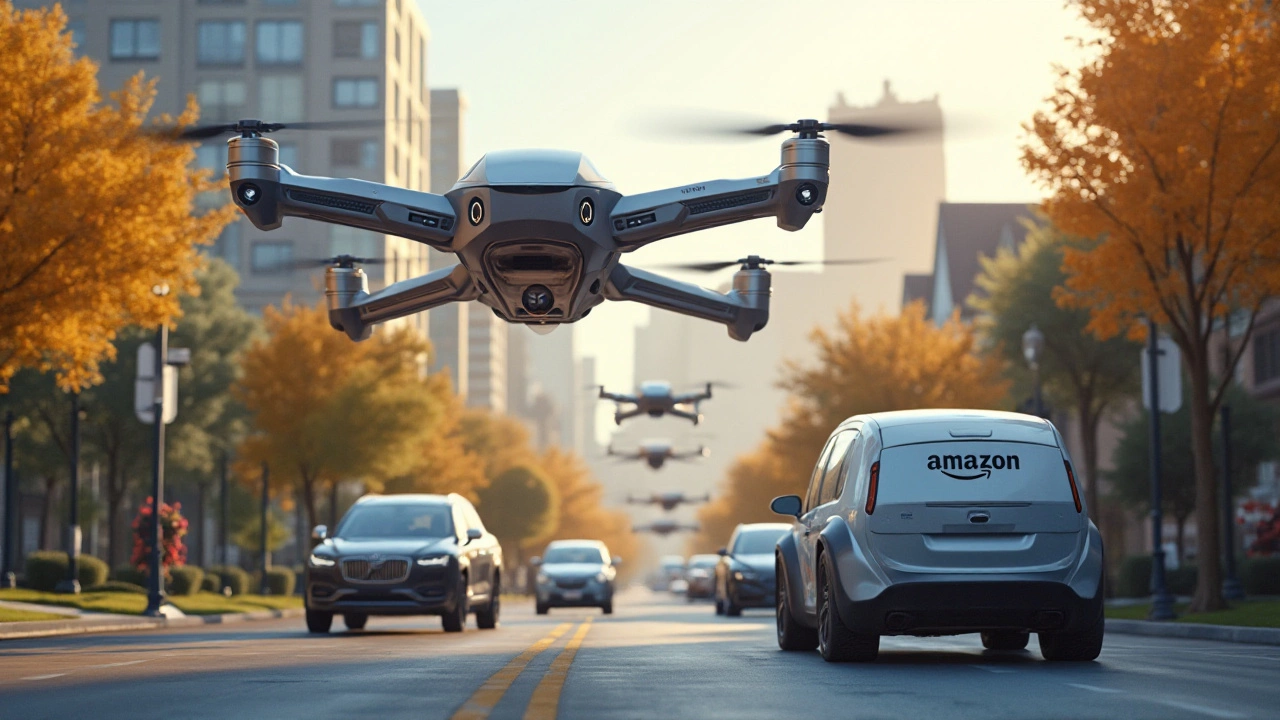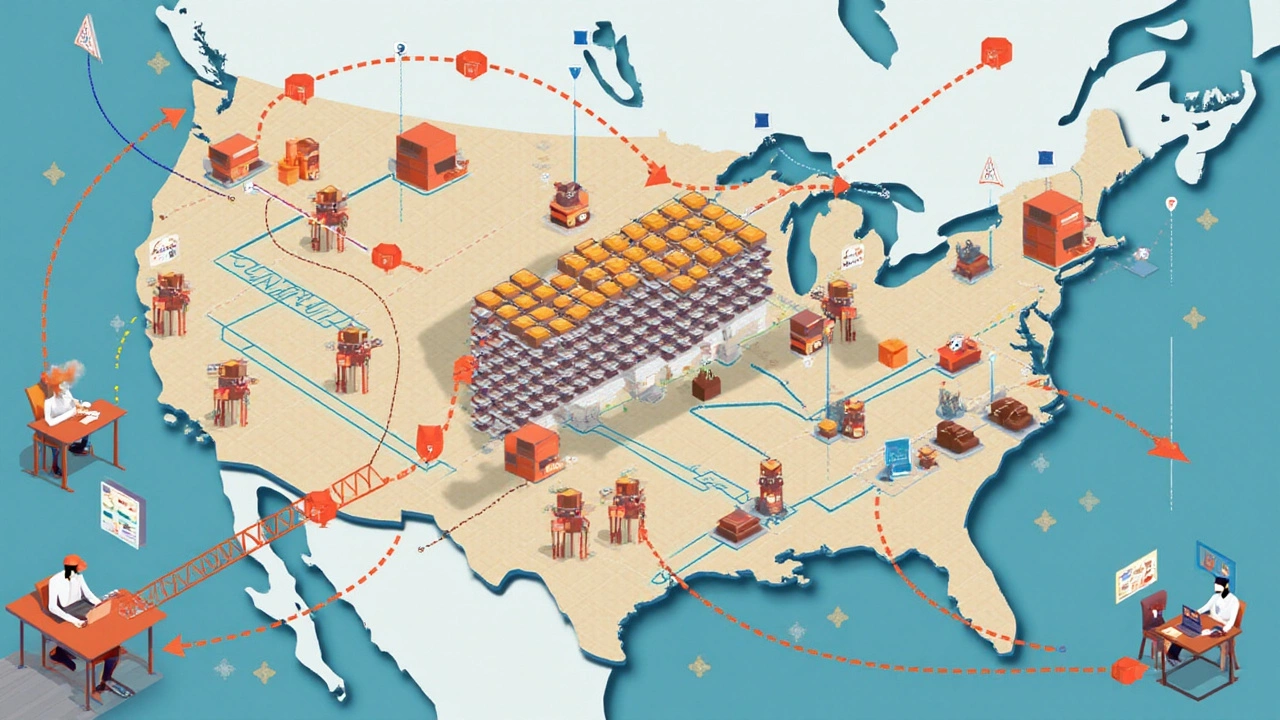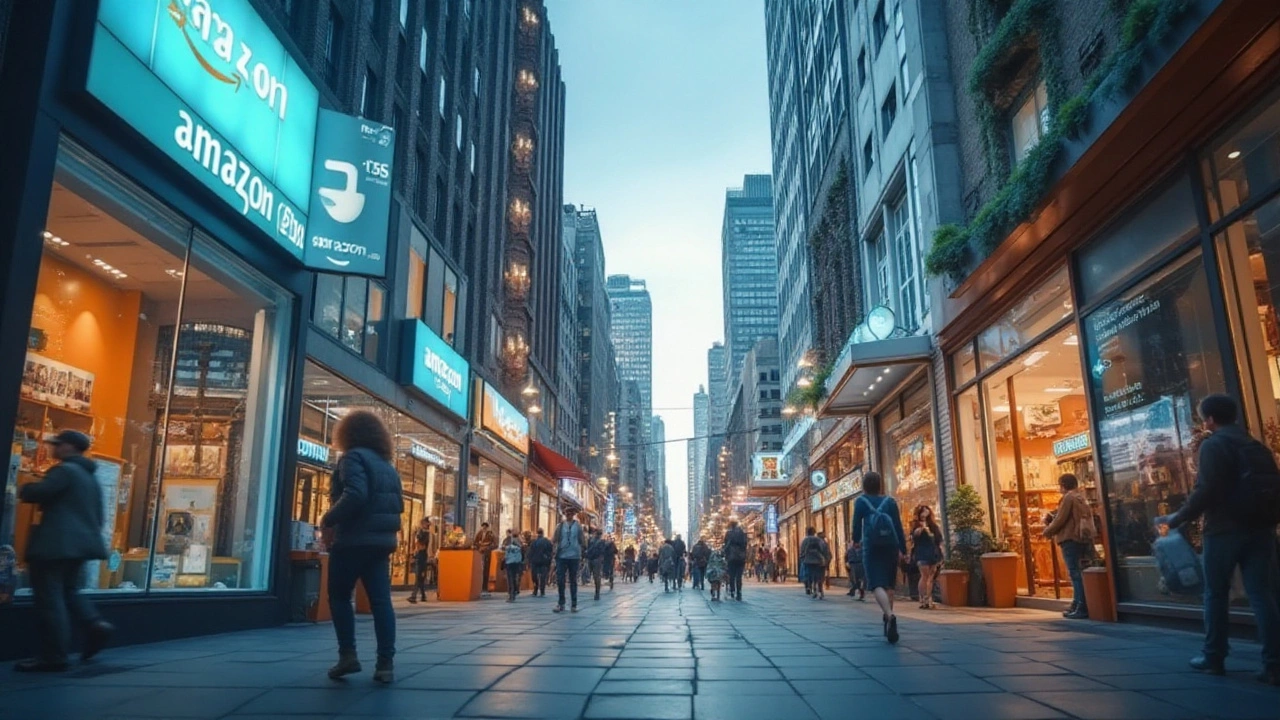In the digital shopping universe, the United States has witnessed a dramatic shift over the years, with e-commerce giants taking the retail sector by storm. This isn't just a tale of stacks of packages at doorsteps or the ever-growing reliance on smartphones but a saga of technological prowess and consumer adaptability.
Amid this revolution, Amazon has become almost synonymous with online shopping, but what exactly propels its vast influence, and who else is trying to catch up? As we delve into this landscape, let's explore the very fabric of these e-commerce behemoths, examining what they do best and where the future might lead them. Fasten your seatbelts as we venture into the bustling world of pixels and packages, where the next big click awaits.
- The Rise of E-Commerce in the USA
- Amazon's Dominance and Its Secrets
- Other Key Players in the Market
- Future Trends and Innovations in E-Commerce
The Rise of E-Commerce in the USA
The United States, a land where innovation and opportunity converge, has seen a meteoric rise in e-commerce over the past two decades. It all started with the humble promise of convenience and variety delivered right to our doorsteps. As the new millennium dawned, early pioneers like eBay and Amazon began reshaping how people thought about shopping. They audaciously stepped into a field dominated by bustling malls and brick-and-mortar stores, offering instead a digital plane filled with limitless potential. These platforms not only removed geographical constraints but also provided an unimaginable range of products, catering to the whims and fancies of every shopper.
From its nascent stages, e-commerce in the USA was not just about cataloging and convenience; it sparked a dramatic evolution in consumer habits. What was once considered a novelty quickly became a necessity. The integration of secure payment systems championed by PayPal and others, alongside improving logistics solutions, bolstered consumer trust and satisfaction. By the year 2020, the onslaught of the global pandemic further accelerated this shift. With physical shopping becoming a challenge, the reliance on digital platforms surged, making e-commerce not just a luxury but a lifeline for people confined to their homes.
As this transformation unfolded, traditional retailers had to adapt or face obscurity. Major retail giants such as Walmart and Target keenly invested in online infrastructures, integrating their offline strengths with burgeoning digital prowess to recapture and expand their customer base. This blend of the physical and digital, aptly termed "omnichannel" retailing, showcased a necessary evolution born out of the competitive e-commerce landscape. Even emerging technologies like AI and machine learning found their roles, predicting consumer preferences and enhancing personalized shopping experiences.
According to a study by the U.S. Department of Commerce, e-commerce sales topped $1 trillion for the first time in 2022, reflecting a 41.8% increase from the previous year.
These remarkable shifts speak volumes about the adaptability and resilience of the American market. Logistics and delivery networks have become the unsung heroes of this revolution. Giants like FedEx and UPS have innovated tirelessly to handle the staggering demands of e-commerce, ensuring timely deliveries and returns. Simultaneously, newer business models have flourished, from subscription boxes to online-only flash sales, continuously enticing shoppers with unique experiences and offerings. Such dynamism suggests that the entrepreneurial spirit is very much alive in this digital era.
The trajectory of e-commerce in the USA paints a vivid narrative of change, resilience, and growth. Driven by relentless technological advancements and consumer enthusiasm, e-commerce has become an integral part of everyday life. As we look into the future, this sector stands poised on the brink of more innovations, ready to redefine convenience and choice once more. The question remains not if e-commerce will grow, but how it will continue to reshape our lives.

Amazon's Dominance and Its Secrets
Amazon's journey to becoming the undisputed leader in eCommerce has been a story of relentless ambition and innovation. At the heart of its strategy lies a unique blend of technology, customer-centric policies, and an unmatched logistical network. One of the key pillars of Amazon's success is its vast warehouse network, which allows the company to fulfill orders at lightning speed. This logistical prowess was a game-changer in an era where consumers expect immediate gratification. From its humble beginnings as an online bookstore, Amazon rapidly diversified its offerings, providing virtually anything you can imagine. By tapping into data analytics, the company could predict consumer needs, personalize shopping experiences, and streamline its operations.
Another secret to Amazon's dominance is its Prime membership program, which transformed how people perceive online shopping. By offering benefits such as free shipping, exclusive access to movies, music, and more, Amazon turned shopping into a holistic experience. This not only encouraged customer loyalty but also created a sense of belonging among its users. Prime Day sales have become an annual event that sparks a shopping frenzy, underscoring the brand's influence. Moreover, Amazon's ability to innovate continuously has kept it ahead of the curve. From the introduction of Echo devices powered by Alexa to ventures into cloud computing with Amazon Web Services, the company has diversified its business beyond retail, further solidifying its market position.
Amazon's knack for acquiring disruptive technologies and integrating them into its ecosystem is also noteworthy. Acquisitions like Whole Foods Market helped bridge the gap between online and offline retail, showcasing Amazon's intent to dominate various segments of the shopping sector. Yet, this dominance doesn't come without challenges. The company has faced scrutiny over its business practices, employee treatment, and impact on small businesses. Despite these hurdles, Amazon's robust, customer-first approach keeps it a step ahead. As Jeff Bezos once said, "We see our customers as invited guests to a party, and we are the hosts. It's our job every day to make every important aspect of the customer experience a little bit better."
True to this principle, Amazon continuously invests in enhancing its logistics infrastructure, AI-driven recommendations, and seamless payment systems, maintaining its edge in a rapidly evolving market. Its strategic ventures into areas like streaming services and AI-driven groceries show a clear intent to expand into every aspect of consumer life. Amazon's secret weapon may well be its culture of unending curiosity and the ability to forecast market trends. By continuously adapting its strategies, it ensures that it remains at the forefront of a fast-paced industry, making it unthinkable not to consider Amazon when discussing giants of online shopping.

Other Key Players in the Market
When it comes to the bustling world of e-commerce in the USA, it's impossible not to think of Amazon as the frontrunner. Yet, there are several other formidable players making significant inroads in this digital retail space. Each of these companies brings its own unique contributions and strategies to the table, challenging Amazon's supremacy in one way or another. Walmart, for instance, leverages its vast network of physical stores to offer customers a seamless omnichannel experience. Customers can easily order online and pick their purchases up in-store, catering especially to those who prefer immediate gratification over waiting for deliveries.
Walmart's focus on pickup and delivery services has increased its competitiveness in the e-commerce arena. Alongside Walmart, eBay remains a stalwart in online auctions and sales, providing an open marketplace where buyers and sellers can connect over a variety of items, both new and used. Its model, sustained over decades, appeals to those looking for unique or second-hand goods that they might not find elsewhere. Then there's Target, which has cultivated a loyal customer base through a combination of sleek branding and strategic investments in technology. Target’s same-day delivery service, Shipt, and their drive-up services, have seen a substantial uptick, especially during the pandemic period.
Moreover, the grocery sector cannot be left unmentioned, with companies like Instacart revolutionizing how consumers approach grocery shopping. By partnering with numerous big-name grocery chains, Instacart has managed to capture a vast market share through convenience and efficiency, aiding in quickly getting groceries to consumers' doorsteps. And let’s not forget Shopify, though not an online store, enables tens of thousands of small businesses to partake in the online marketplace by providing the tools necessary to establish their digital storefronts.
Considering all these players, it's evident that the USA's e-commerce landscape is both diverse and dynamic. Each competitor in this retail race contributes to the continuous evolution and consumer-oriented shift we see unfolding. The strategies of these enterprises highlight different consumer needs, preferences, and shopping behaviors, adding layers to what an online shopping experience can offer today.
"In this rapidly changing world, it's not the biggest fish eating the small one, it's the fastest fish that eats the slow one," says John Chambers, ex-CEO of Cisco, which interestingly reflects the pace at which companies must innovate to gain an edge in the e-commerce market.
Understanding these dynamics is essential for anyone interested in the mechanisms behind the pixels that power the purchases we make in an increasingly online world. With such rapid growth and innovation, it's truly a fascinating time to observe and participate in this digital marketplace extravaganza.

Future Trends and Innovations in E-Commerce
As the sands of the digital landscape continue to shift, e-commerce in the United States is set to evolve in captivating ways. First and foremost, the integration of artificial intelligence is setting the stage for a noticeably smarter shopping experience. Retailers are increasingly harnessing AI to provide personalized recommendations, chatbots, and automated customer service, significantly enhancing how we shop online. Imagine the comfort of having a virtual assistant that not only knows your preferences but can predict your needs before you even realize them. AI is not a distant possibility but an integral part of modern e-commerce strategies. What makes this transformation tangible is its ability to make shopping tailored and intuitive.
Another exciting frontier is the fusion of virtual and augmented reality (AR/VR) into the e-commerce journey. This innovation is changing how consumers interact with products, creating a more immersive and engaging shopping environment. From virtually trying out clothes to envisioning furniture in your living room, AR/VR technology is making shopping convenient and fun. However, bringing these technologies to everyday consumers involves overcoming challenges such as device compatibility and infrastructure needs. Nonetheless, companies that crack this code will likely see a surge in consumer interest and loyalty. It's a path leading to an extraordinary shopping experience that feels as real as walking into a physical store.
Additionally, the rise of social commerce is adding a new dimension to online shopping, turning social networks into shopping platforms. Platforms like Instagram and TikTok are becoming more than just places to connect, as they evolve into direct shopping channels where users can purchase products without leaving the app. This trend capitalizes on the seamless connection between consumer engagement and actual transactions, providing an instinctive route for sellers to reach their audience. Social commerce bridges the gap between discovery and purchase, making the process quick and intuitive.
"The seamless integration of e-commerce within social platforms marks a paradigm shift in how consumers discover and buy products," says Jane Smith, a digital retail strategist.
Finally, sustainability is becoming a focal point for shoppers and retailers alike. Consumers are increasingly aware of their environmental footprint, and brands that align with these values tend to capture more significant attention. This trend is driving companies to adopt eco-friendly practices, such as recyclable packaging, energy-efficient delivery methods, and the promotion of green products. Businesses are not only reducing their environmental impact but also connecting with a growing segment of environmentally conscious shoppers. The blend of commerce and sustainability signals a promising shift that could redefine how businesses operate in harmony with the planet.
Let us not forget the undercurrent of change driven by improved logistics and distribution networks that continue to reshape e-commerce. The introduction of drones and automated delivery vehicles are pushing the boundaries of what is considered possible in getting orders into consumers' hands swiftly and reliably. As logistics technology advances, the potential for faster delivery times increases, making the customer experience seamless from click to doorstep. This logistical overhaul requires a keen understanding of technology and operational efficiency, ensuring that the end-user reaps the benefits of innovation at every step.


